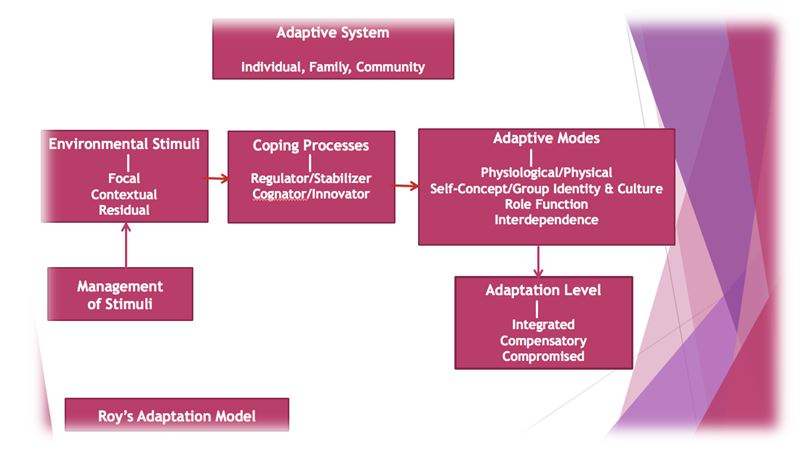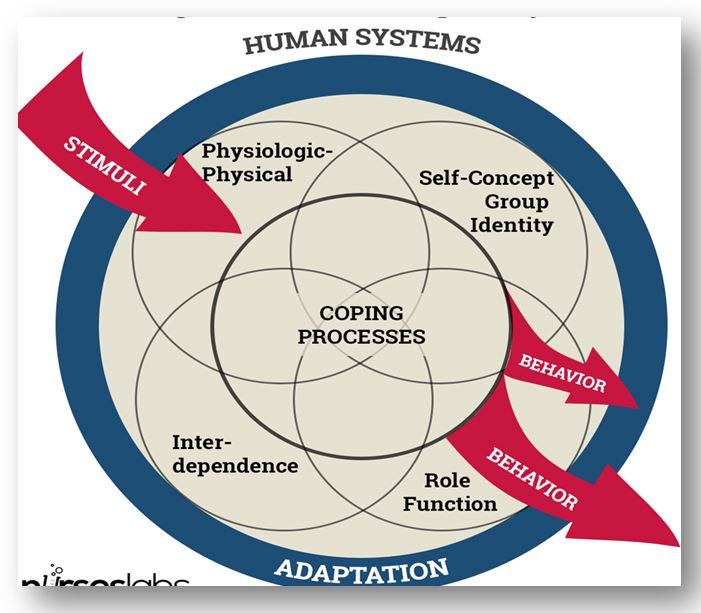Introduction
Sister Calista Roy is a nursing theorist, writer, and professor known for her exemplary contribution to nursing. Born in 1939, Roy went to school where she studied until she received a degree in nursing from St. Mary’s College, LA, in 1963 (Callis, 2020). She is known for her revolutionary role in developing what is known as the Adaptation Model of Nursing. The model was created after she was challenged in a nursing seminar to form a conceptual model that nurses would use. In Roy’s theory, the model embraces a person as a set of interrelated components that are used to maintain a balance between many stimuli. The interrelationship is in the form of biological, psychological, and social perspectives (Maryati et al., 2018). Roy’s theory states that a person is a set of interrelated systems in terms of biological, social and sociological and through the framework, nurses can find guidelines in their scope of clinical practice (Callis, 2020). Calista Roy significantly contributed in field of nursing by developing nursing process and enlightening nurses about metrics which boost their clinical duties through the adaptation model in nursing and save patients life.
Roy’s Contribution to Professional Nursing, Practice, and Knowledge
Calista Roy contributed to the field of nursing through her clinical adaptation model. As seen in Figure 1 below, the theory contains four domains related to a person, environment, health, and nursing. In Roy’s theory, six steps in the nursing process can be identified. In the framework, a person represents an individual or group where a biopsychological being interacts with a dynamic environment (Smith & Gullett, 2020). Roy explains to nurses that the person factor in the model is open and adaptive in that they can use coping skills to deal with constraints (Maryati et al., 2018). In terms of environment, Roy sees it as any condition, circumstance, and influence that surround and affects how a person behaves. The stressors described by Roy are stimuli, and they are described as residential stimuli meaning that they influence a person. While adopting Roy’s concepts, nurses understand that illness and health are continuous with various possible states and degrees (Maryati et al., 2018). Therefore, nurses have been influenced to believe that health is a process in which a person is integrated to become complete or whole.

The goal of nursing, as per Roy, is to promote the adaptation of the four domains, which leads to a person’s health, a life that has quality and dignity in case one dies. That is enabled by integrating physiological, self-concept, interdependence, and role function. Additionally, Roy contributed to field of nursing by developing a process that comprises six steps, as seen in Figure 2. These steps allow nurses to have an evidence-based course of action while undertaking their clinical duties. The first step involves observation of the person’s behavior in all four domains. That behavior helps nurses compare the norms and deem them adaptive or unsuccessful (Gamal et al., 2019). In the second step, Roy helps nurses understand factors influencing an individual’s behavior. At this point, nurses can relate that stimulus can be focal, residual, or contextual. Nurses can use diagnosis to ineffective state behaviors while identifying the cause of the problem (Gamal et al., 2019). The aspect of dealing with patients to form part of nursing problems and alters the relationship between nurses and patients depending on the stimuli.

Lastly, goal setting is undertaken where there must be realistic and attainable objectives that collaborate with the person. Roy helps nurses find ways to set goals for the patients, which can be either short-term or long-term goals. At the last stage, nurses can know how to intervene clinically after combatting the stimuli (Nurlela et al., 2018). Thus, Roy’s model is an effective framework that helps nurses to understand various metrics in their professional duties. Nurses who apply the adaptation model by Roy are enabled to perform their duties without any gap in understanding their work.
Roy’s Nursing Contributions to Practical Experience
Roy’s adaptive model is widely used in nursing practice to guide practical experiences in direct research and education. The model develops a framework for providing exemplary and quality clinical care. Through Roy’s theory, nurses have obtained interventions that overcome challenges experienced by patients and lower perceived symptoms while increasing the quality of life for an individual (Nurlela et al., 2018). Evaluating patients based on their physiological and interdependent functions leads to holistic care, courtesy of Roy’s contributions.
Adaptation theory can be applied in various ways regarding nursing experiences. For example, the model can be useful in linking children and their parents when leaning on adaptive psychological perspectives. That is achievable if a nurse understands that environmental stimuli can enhance or worsen someone’s ability to adapt to a particular issue (Gamal et al., 2019). The nurses will use this knowledge to encourage parents to love and support the constructive behaviors of their children to enhance their ability to adapt to any challenge. In that case, nurses will discourage hostility from parents toward their children so that they do not alter adaptation (Gamal et al., 2019). The clinical metrics are meant to ensure that a child grows with a positive reflection of life and they do not risk psychological problems which may adversely affect their lives.
In the adaptation process, nurses can play roles in patient recovery by collaboratively optimizing patients’ comfort during care. For instance, nurses will recognize the symptoms patients have and take the right measures under their scope of practice to offer medical solutions hence, they can provide possible measures to alleviate the symptoms based on their understanding of the patient’s adaptation. Roy’s framework comprises holistic care, meaning interventions will consider bio-psycho-social constraints (Smith & Gullett, 2020). An example is when a patient with breast cancer undergoes a breast-conserving operation, and nurses will use coping interventions, such as letting the patient know they may have bodily changes, where hair loss would be evident.
How Roy’s Model Can be Applied by Graduates
Registered nurses (RNs) can use Roy’s adaptation theory to offer various contributions to nursing paraphernalia. RNs need to understand that Roy aims to increase compliance and life expectancy. A new graduate may use theoretical perspectives from Calista Roy to plan and execute care with purpose and proactiveness (Nurlela et al., 2018). For instance, a patient hospitalized with arthritis can be guided through applying the model’s concept on how to prevent possible adverse exacerbations by stretching. In this case, an RN will observe to know environmental stimuli that can help a patient concentrate on the occurrence and overlook their pain. The nurse will give the patient the benefit of positively responding to their stimuli as one way of adapting, hence, clinically offering exemplary care to the patient, which may increase his life quality.
Conclusion
Calista Roy is a nursing theorist who developed adaptation model. In the model, a person is perceived to be interrelated in terms of social, psychological and biological perspectives. Roy’s concepts can help nurses to navigate their clinical duties. Adaptation model is useful in knowing stimuli for given environment from where a nurse can take necessary action. The model is useful to guide nurses on the process of care through steps that are relevant to medical delivery.
References
Callis, A. M. (2020). Application of the Roy adaptation theory to a care program for Nurses. Applied Nursing Research, 56(41), 151–340. Web.
Gamal, A., Ayoub, G., Khalil, A., & Hussein, A. (2019). Effect of nursing care guided by Roy’s adaptation model on self-evaluation of women after cesarean section. Journal of Health, Medicine, and Nursing, 4(6), 28–31. Web.
Maryati, I., Sukmawati, S., & Mamuroh, L. (2018). The application of “Roy adaptation” theory model in women with early stage of cervical cancer: A study case. Journal of Maternity Care and Reproductive Health, 1(2), 26–34. Web.
Nurlela, L., Harfika, M., & Novitasari, L. E. (2018). Family support relationships with patient adaptation ability above with diagnosis hallucination of post care. Proceedings of the 9th International Nursing Conference, 3(6), 22–28. Web.
Smith, M. C., & Gullett, D. L. (2020). Nursing theories and nursing practice. F.A. Davis Company.